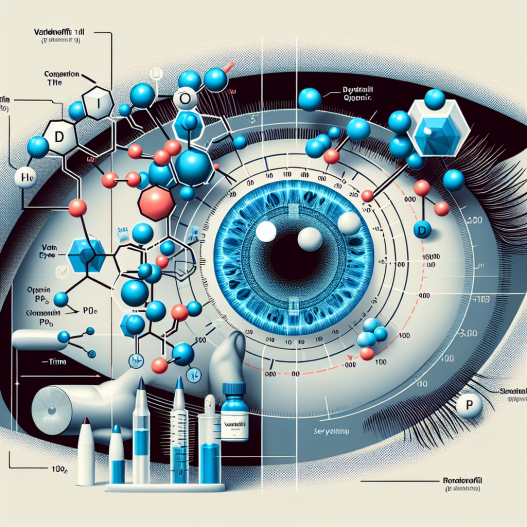-
Table of Contents
«Vardenafil: Enhancing performance, not vision.»
Introduction
Vardenafil, commonly known as Levitra Generic, is a medication used to treat erectile dysfunction in men. It belongs to a class of drugs called phosphodiesterase type 5 (PDE5) inhibitors, which work by increasing blood flow to the penis during sexual stimulation. While Vardenafil is generally well-tolerated, there have been some concerns about its potential effects on vision. In this article, we will explore whether Vardenafil can influence vision and what precautions should be taken when using this medication.
The Potential Side Effects of Vardenafil (Levitra Generic) on Vision
Vardenafil, commonly known by its brand name Levitra, is a medication used to treat erectile dysfunction (ED) in men. It belongs to a class of drugs called phosphodiesterase type 5 (PDE5) inhibitors, which work by increasing blood flow to the penis, allowing for a stronger and longer-lasting erection. While Vardenafil has been proven to be effective in treating ED, like any medication, it may also come with potential side effects. One of the concerns that have been raised is whether Vardenafil can have an impact on vision.
Before delving into the potential effects of Vardenafil on vision, it is essential to understand how this medication works. As mentioned earlier, Vardenafil works by increasing blood flow to the penis, which is necessary for achieving and maintaining an erection. However, this increase in blood flow can also affect other parts of the body, including the eyes. The eyes, like the penis, require a steady blood flow to function correctly. Therefore, any changes in blood flow can potentially affect vision.
One of the most common side effects of Vardenafil is changes in vision. These changes can range from mild to severe and may include blurred vision, sensitivity to light, and changes in color perception. These side effects are usually temporary and may subside as the medication wears off. However, in some cases, they may persist, and it is essential to seek medical attention if this happens.
The reason behind these changes in vision is the effect of Vardenafil on the blood vessels in the eyes. As the medication increases blood flow to the penis, it also causes the blood vessels in the eyes to dilate, resulting in changes in vision. This dilation can also lead to an increase in intraocular pressure, which can be problematic for individuals with pre-existing eye conditions such as glaucoma.
Another potential side effect of Vardenafil on vision is a condition called non-arteritic anterior ischemic optic neuropathy (NAION). NAION is a sudden loss of vision in one or both eyes, which occurs due to a lack of blood flow to the optic nerve. While the exact cause of NAION is still unknown, it has been linked to the use of PDE5 inhibitors such as Vardenafil. This condition is rare, but it is essential to be aware of its potential risks.
Individuals who are at a higher risk of developing NAION include those over the age of 50, individuals with a history of heart disease, diabetes, high blood pressure, and those who smoke. It is crucial to inform your doctor of any pre-existing conditions before starting Vardenafil to determine if it is safe for you to use.
It is also worth noting that Vardenafil may interact with other medications, including those used to treat eye conditions such as macular degeneration and retinitis pigmentosa. Therefore, it is crucial to inform your doctor of all the medications you are taking, including over-the-counter drugs and supplements, before starting Vardenafil.
In conclusion, while Vardenafil has been proven to be an effective treatment for ED, it is essential to be aware of its potential side effects, particularly those related to vision. Changes in vision, including blurred vision, sensitivity to light, and changes in color perception, are common side effects of Vardenafil. However, in rare cases, it may also lead to more severe conditions such as NAION. Therefore, it is crucial to inform your doctor of any pre-existing conditions and medications you are taking before starting Vardenafil. If you experience any changes in vision while taking this medication, it is essential to seek medical attention immediately.
Understanding the Mechanism of Action of Vardenafil (Levitra Generic) and its Impact on Vision
Vardenafil, commonly known by its brand name Levitra, is a medication used to treat erectile dysfunction (ED) in men. It belongs to a class of drugs called phosphodiesterase type 5 (PDE5) inhibitors, which work by increasing blood flow to the penis, allowing for a sustained erection. While it has been proven to be an effective treatment for ED, there have been concerns about its potential impact on vision. In this article, we will delve into the mechanism of action of vardenafil and explore its potential effects on vision.
To understand how vardenafil may affect vision, it is important to first understand its mechanism of action. When a man is sexually stimulated, the body releases nitric oxide, which activates an enzyme called guanylate cyclase. This enzyme then increases the levels of a chemical called cyclic guanosine monophosphate (cGMP), which relaxes the smooth muscles in the penis and allows for increased blood flow. PDE5 is an enzyme that breaks down cGMP, thus limiting its effects. Vardenafil works by inhibiting PDE5, allowing cGMP levels to remain elevated and promoting a sustained erection.
Now, let’s explore the potential impact of vardenafil on vision. Some studies have suggested that PDE5 inhibitors, including vardenafil, may have a temporary effect on vision. This is because PDE5 is also present in the retina, the part of the eye responsible for converting light into signals that are sent to the brain. By inhibiting PDE5, vardenafil may also affect the levels of cGMP in the retina, potentially altering the way the retina responds to light.
However, it is important to note that these effects are temporary and usually resolve within a few hours. In fact, a study published in the Journal of Ocular Pharmacology and Therapeutics found that vardenafil had no significant impact on visual function in healthy men. Another study published in the Journal of Sexual Medicine also found no evidence of changes in visual function in men taking vardenafil for ED.
Furthermore, the United States Food and Drug Administration (FDA) has not found any evidence of a direct link between vardenafil and vision changes. In fact, the FDA has approved vardenafil for the treatment of ED, indicating that it is safe for use in men with this condition.
It is also worth noting that vardenafil may interact with certain medications that are used to treat eye conditions, such as alpha-blockers and nitrates. These medications can lower blood pressure and may increase the risk of side effects when taken with vardenafil. Therefore, it is important to inform your doctor of any medications you are taking before starting vardenafil.
In rare cases, some men may experience a sudden decrease or loss of vision while taking vardenafil. This is known as non-arteritic anterior ischemic optic neuropathy (NAION) and is a serious condition that requires immediate medical attention. However, it is important to note that NAION is not caused by vardenafil, but rather by underlying health conditions such as diabetes, high blood pressure, or heart disease. Therefore, it is crucial to inform your doctor of any pre-existing health conditions before taking vardenafil.
In conclusion, while there have been concerns about the potential impact of vardenafil on vision, the evidence suggests that any effects are temporary and do not pose a significant risk. Vardenafil remains a safe and effective treatment for ED, and its benefits far outweigh any potential risks. However, it is important to always consult with your doctor before starting any new medication and to inform them of any pre-existing health conditions or medications you are taking. By understanding the mechanism of action of vardenafil and its potential effects on vision, you can make an informed decision about whether it is the right treatment for you.
Managing Vision Changes Caused by Vardenafil (Levitra Generic): Tips and Precautions
Vardenafil, commonly known by its brand name Levitra, is a medication used to treat erectile dysfunction (ED) in men. It works by increasing blood flow to the penis, allowing for a stronger and longer-lasting erection. While this medication has proven to be effective in treating ED, there have been concerns about its potential impact on vision. In this article, we will explore the relationship between vardenafil and vision changes, as well as provide tips and precautions for managing any potential side effects.
First and foremost, it is important to note that vardenafil has been approved by the Food and Drug Administration (FDA) as a safe and effective treatment for ED. However, like any medication, it may cause side effects in some individuals. One of the reported side effects of vardenafil is changes in vision, including blurred vision, sensitivity to light, and changes in color vision. These side effects are usually mild and temporary, but in rare cases, they can be more severe and long-lasting.
So, how does vardenafil affect vision? The medication works by inhibiting an enzyme called phosphodiesterase type 5 (PDE5), which is responsible for breaking down a chemical called cyclic guanosine monophosphate (cGMP). cGMP is essential for relaxing the muscles in the blood vessels, allowing for increased blood flow to the penis. However, PDE5 is also present in other parts of the body, including the eyes. By inhibiting PDE5, vardenafil can also affect the blood vessels in the eyes, leading to changes in vision.
If you experience any vision changes while taking vardenafil, it is important to consult your doctor immediately. They will be able to assess the severity of the side effects and determine the best course of action. In most cases, the side effects will subside on their own within a few hours. However, if they persist or worsen, your doctor may recommend stopping the medication or adjusting the dosage.
In addition to consulting your doctor, there are also some tips and precautions you can take to manage vision changes caused by vardenafil. First and foremost, it is important to follow the recommended dosage and not exceed it. Taking more than the prescribed amount can increase the risk of side effects, including changes in vision. It is also important to avoid alcohol and grapefruit juice while taking vardenafil, as they can increase the concentration of the medication in your body and potentially worsen side effects.
Another tip for managing vision changes is to take the medication at least 30 minutes before engaging in sexual activity. This will give your body enough time to absorb the medication and reduce the risk of side effects. It is also recommended to avoid driving or operating heavy machinery while taking vardenafil, as changes in vision can affect your ability to perform these tasks safely.
If you have a history of eye problems, such as retinitis pigmentosa or non-arteritic anterior ischemic optic neuropathy (NAION), it is important to inform your doctor before starting vardenafil. These conditions can increase the risk of vision changes and may require special precautions or a different treatment plan.
In conclusion, vardenafil (Levitra Generic) can potentially cause changes in vision as a side effect. However, these side effects are usually mild and temporary, and can be managed by following the recommended dosage, avoiding alcohol and grapefruit juice, and consulting your doctor if necessary. By being aware of the potential risks and taking necessary precautions, you can safely and effectively manage ED with vardenafil. Remember to always consult your doctor before starting any new medication and to report any side effects you may experience.
Q&A
1. ¿Puede Vardenafil afectar la visión de una persona?
Sí, Vardenafil (Levitra Generic) puede influir en la visión de una persona. Algunos efectos secundarios comunes de este medicamento incluyen visión borrosa, cambios en la percepción del color y sensibilidad a la luz.
2. ¿Estos efectos secundarios en la visión son permanentes?
No necesariamente. Estos efectos secundarios suelen ser temporales y desaparecen una vez que el medicamento es eliminado del cuerpo. Sin embargo, si experimenta cambios en la visión que persisten o empeoran, es importante que consulte a su médico de inmediato.
3. ¿Quiénes deben tener precaución al tomar Vardenafil en relación a su visión?
Las personas que tienen problemas de visión preexistentes, como degeneración macular o retinitis pigmentosa, deben tener precaución al tomar Vardenafil. También se recomienda evitar el consumo de alcohol en exceso mientras se toma este medicamento, ya que puede aumentar el riesgo de efectos secundarios en la visión. Si tiene alguna preocupación sobre su visión al tomar Vardenafil, hable con su médico.












